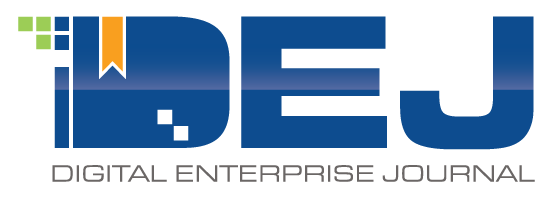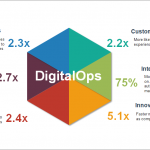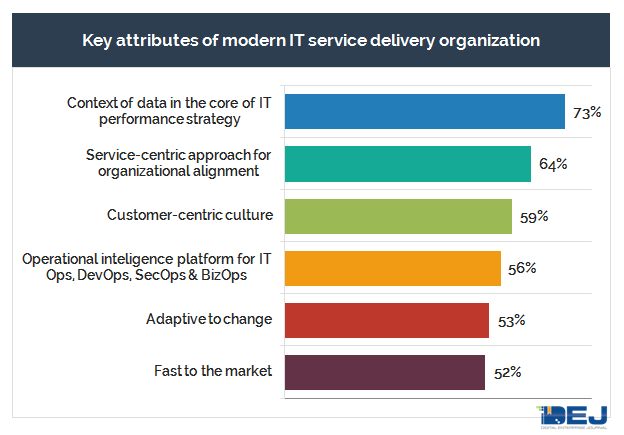DEJ published a new study on the 2020 state of IT performance management. The study titled “19 Key Areas Shaping IT Performance Markets in 2020” is based on insights from more than 3,100 organizations and reveals major changes in these markets that span across all of the key domains – from buyers’ requirements and market drivers to deployments of new capabilities and approaches to solving key issues.
New market requirements
DEJ’s study “17 Areas Shaping the IT Operations Market in 2018” revealed some new dynamics that were causing a major power shift in these markets. This new study shows that these dynamics became even more important over the last 24 months while new and emerging areas are further redefining these markets.
Customer is king and keeps asking for more
Addressing increased customer expectations for experience and engagement is the driver behind each of the 19 areas identified in the research. Addressing this market pressure has a major impact on redesigning processes, establishing new organizational structure, approach and culture, introducing new criteria for evaluating vendors and is driving a demand for new technology capabilities.
The study also shows that taking a customer-centric approach for managing IT is not only becoming more important, but also more difficult to execute. The research shows a 31% decline in the number of organizations that are using the number of trouble tickets as a measure of performance. Additionally, 39% reported that the average application latency when business performance starts to deteriorate decreased over the last 12 months. The combination of customers expecting faster applications and better digital experiences and IT’s increased understanding that both 1 and 1,000 user trouble tickets issued are an indicator of failing is driving the need for proactive and customer-centric approach to managing IT.
The best answer to “what does it mean to the business?” wins
Fifty-two percent of LoB managers in DEJ’s 2019 study “The Roadmap to Becoming a Top Performing Organization in Managing IT Operations” reported that the impact of IT Operations to the business goals has to be clearer. This study shows that the key reasons for that is an inability to translate technology value proposition into business outcomes. That is a major issue, as 60% of organizations reported the impact on business outcomes as the key criteria for selecting IT performance management solutions (a 75% increase over the last 2 years).
Additionally, 40% of organizations reported that the metrics that IT Operations vendors are focused on improving are not critical to the business. The bottom line is – IT performance management solutions are making a significant impact on business outcomes, and findings of this study clearly support that. However, that is not obvious to IT and business decision makers. Therefore, technology vendors need to do a much better job of connecting the dots between the value of their solutions and desired business outcomes.
Managing new environments is turning this market upside down
DEJ’s recent research shows that managing cloud performance is a key requirement and not just a use case for IT performance management solutions. Sixty-six percent of organizations in DEJ’s recent study reported that their visibility into IT performance declined after deploying cloud services. Additionally, DEJ’s guest blog post shows that, for 63% of organizations, it takes longer to troubleshoot and resolve performance issues when managing hybrid cloud.
When defining their IT performance management strategies, organizations need to take into account that managing performance and microservices requires a whole new set of competencies. For those that ignore that, the study shows:
- There is a significant cost of trying to outsmart your self – $254,000 more spent annually, on average, by organizations that are taking a “do it yourself” approach for managing the performance of microservices, as compared to all others
- It’s inevitable, so it’s better to do it sooner rather than later – the research shows that the majority of organizations do invest in new management capabilities after deploying cloud and microservices, but the majority of them fully recognizes that need 6-12 months later
Fifty-eight percent of organizations reported that they are selecting their IT performance management solutions based on a situational alignment (technology environment managed, use case, etc.) while another 51% are using enablement of modernization and transformation efforts as the key selection criteria. Managing dynamic technology environments is changing the way in which organizations go about technology purchases and recognizing unique requirements for these settings (and recognizing them early) is becoming increasingly important.
Actionable insights is the name of the game
The study shows a 76% increase in the number of organizations reporting that making IT data actionable as their key goal. Also, the study shows that the impact of improving the ability to collect more IT monitoring data on performance metrics is fairly weak. Putting monitoring data into actionable context is the key for addressing all major performance challenges and should be a starting point for creating successful management strategies.
This was the major story of DEJ’s 2018 study and, even though the research shows that organizations are becoming more aware of the importance of creating actionable insights, the majority of them still have a long way to go in this area.
Three magic words – speed, simplicity, reliability
The study shows that organizations are 54% more likely to use time to value than range of capabilities or completeness of the solution as a key selection criteria. Additionally, 64% of organizations are looking to deploy a real-time platform for processing IT data. DEJ’s recent study on IT transformation shows a 2.7 times increase in new technology deployments since 2016 and organizations are looking to build capabilities to be rapidly able to adjust to an increasing amount of change and complexity.
Additionally, DEJ’s recent research shows a 2.1 times increase in the number of organizations using technology to differentiate from competitors since 2017. As organizations are going down the path of digital transformation, the study shows that reducing the risk of deploying new transformational technologies is the #1 role of IT performance solutions in digital economy. That shows that ensuring reliability of IT performance is becoming more important than ever and the returns on investments of transformational technology heavily rely on the effectiveness of IT performance management solutions.
2.9 times increase in the number of organizations that have AIOps as their budget item, over the last 12 months
Key enablers
New user requirements are calling for a different mix of management capabilities and innovation on the technology vendors’ side. The study reveals 10 types of technology enablers that showed the highest importance in addressing user requirements:
1 – Automation. 77% of organizations described importance of automation capabilities for managing IT performance in production as “high” or “very high”. Additionally, 76% of organizations listed IT automation as a key capability in helping them to cope with the amount of change.
2 – AIOps. The study shows a 2.9 times increase in the number of organizations that have AIOps as their budget item, over the last 12 months. Additionally, the study reveals a 57% decrease in the number of organizations that perceive AIOps as “unproven” technology since 2018.
3 – Service-centric, unified view. 64% of organizations listed a service-centric approach as a key attribute of a modern IT organization. Additionally, 60% reported that having a unified view into their dynamic environments is the key capability for IT performance management.
4 – Modernizing IT Operations. 36% of organizations are looking to modernize IT Ops around DevOps principles (agility, automations, knowledge management, etc.). The study also shows that organizations are increasingly transitioning from traditional IT operations and adopting the concept of DigitalOps that is defined by 6 principles; 1) customer-centric approach; 2) focus on business outcomes; 3) intelligence and automation; 4) real-time, unified platform; 5) innovation enablement; and 6) proactive and preventative approach.
5 – Need for new generation IT monitoring. 58% of organizations reported “blind spots” on the digital delivery chain as a key challenge. The study also shows that 48% are looking to deploy AIOps and IT monitoring capabilities on the same platform.
6 – New approach to user experience monitoring. 51% of organizations are looking to deploy capabilities for capturing the user’s impact on performance, while 45% listed benchmarking capabilities as a key attribute of their approach for user experience monitoring.
7 – Modern IT service delivery organization. Organizations are looking to transform their approach for delivery of IT services and create a new culture and processes around 6 key attributes (chart below).
8 – Enabling engineering teams and DevOps. 53% of organizations are looking to expand key CI/CD principles into production performance. Additionally, 39% reported that reducing the amount of unplanned work for developers and engineers as a strategic business goal.
9 – Establishing new processes. 57% of organizations are looking to redesign their processes to enable IT to get closer to customers. Additionally, 68% described postmortem capabilities for IT incident management as “important or “very important”.
10 – Enabling MSPs. The study shows a 28% increase in the number of organizations that are outsourcing IT performance management efforts over the last 18 months. Additionally, 49% listed “not looking for another management tool, but a holistic solution” as a key driver for outsourcing their IT performance management initiatives.
The research shows a 91% increase in missed revenue due to performance and availability issues since 2016. As user requirements for managing IT performance are changing at a very fast pace, organizations need to fully understand these new requirements and explore how these 10 technology enablers can help them to create business value by improving their IT performance.
The fact that these markets changed so significantly since DEJ’s 2018 study indicates that the window of opportunity for user organizations to capitalize on changes in customer requirements is getting smaller and, therefore, acting quickly to enhance their capabilities is becoming more critical.















